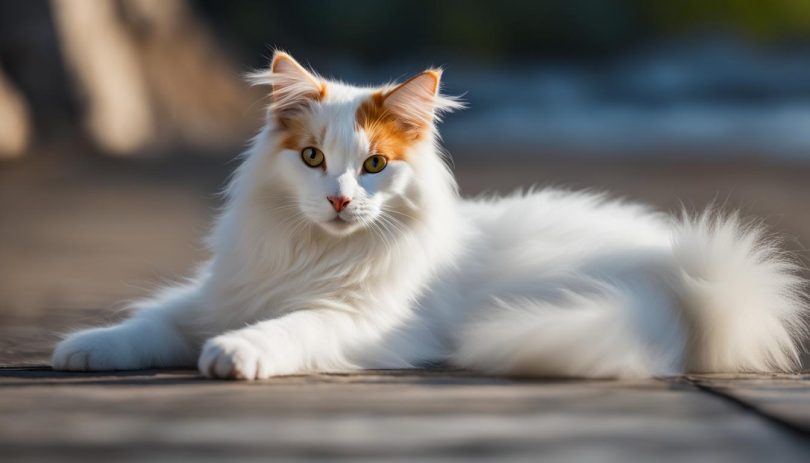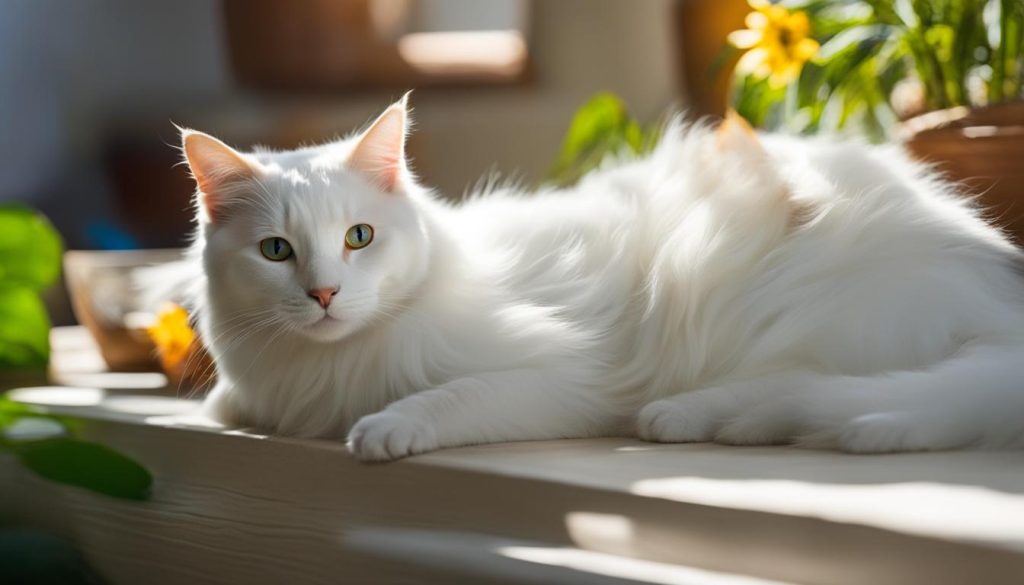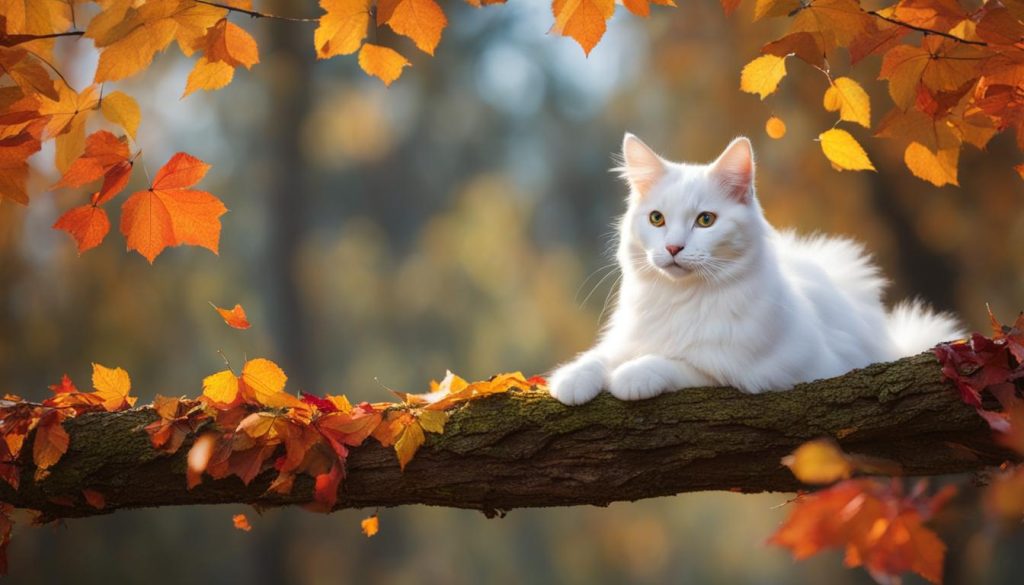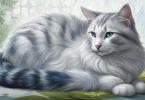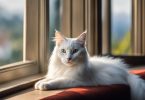As a cat lover and owner, I have had the pleasure of experiencing the unique characteristics of Turkish Van cats firsthand. This playful breed, originating in Turkey, is often referred to as “the swimming cat” due to their love for water. Turkish Van cats are energetic and make wonderful companions, exhibiting traits that set them apart from other breeds. Let’s dive deeper into the fascinating world of Turkish Van cats and learn more about their breed traits and characteristics.
Key Takeaways:
- The Turkish Van cat is a unique and playful breed originating in Turkey.
- They are sometimes referred to as “the swimming cat” due to their love for water.
- Turkish Van cats are energetic and make wonderful companions.
- They have distinct characteristics, including their medium to large size and semi-long white coats with coloration on their heads and tails.
- Turkish Van cats have a loving and loyal personality, enjoying attention and playtime with their owners.
Turkish Van Cat Appearance
Turkish Van cats have a unique and striking appearance that sets them apart from other breeds. They have medium to large bodies with sturdy torsos, full chests, and strong legs, giving them a robust and athletic build. Their heads are relatively large and wedge-shaped, topped with large ears that are reasonably far apart and high up on the skull.
One of the most distinctive features of Turkish Van cats is their semi-long coat. It is mostly white, with coloration on their heads and tails. The patches of color can vary widely, allowing for a beautiful range of patterns and color combinations within the breed. The texture of their coats is thick and luxurious, resembling cashmere and providing insulation against cold weather. Turkish Van cats are also known for their plumed or bottlebrush tail, which adds to their overall elegance.
Another notable feature of Turkish Van cats is their eyes. They come in different shapes, ranging from the classic almond-shaped eyes to rounder shapes like a walnut or peach pit. The color of their eyes is equally captivating, with three possibilities: all blue, all amber, or odd eyes (one blue eye and one amber eye).
| Turkish Van Cat Appearance | Description |
|---|---|
| Turkish Van Body Size | Medium to large with sturdy torsos, full chests, and strong legs |
| Coat | Semi-long, mostly white with coloration on the head and tail |
| Tail | Plumed or bottlebrush tail |
| Eyes | Varying shapes (walnut, peach pit, almond) and colors (blue, amber, odd eyes) |
Overall, Turkish Van cats have a unique and captivating appearance that reflects their individuality as a breed. Their robust build, semi-long coat, and striking eyes make them a visually stunning addition to any home.
Turkish Van Cat Behavior and Temperament
When it comes to behavior and temperament, Turkish Van cats are known for their loving and loyal nature. They enjoy affection and cuddling but prefer to initiate contact with their owners. These cats are curious and playful, often engaging in activities that involve exploring and investigating their surroundings. Their mischievous streaks bring energy and entertainment into the lives of their owners, making them delightful companions.
Turkish Van cats are intelligent animals and require mental stimulation and playtime to prevent boredom. Providing them with interactive toys and opportunities for play will keep them engaged and happy. They are generally good with other pets, including cats and dogs, as long as they establish themselves as the ones in charge. However, due to their dislike of being picked up or held for extended periods, they may not get along well with young children.
Overall, Turkish Van cats have a sweet and affectionate nature that makes them wonderful companions for those who appreciate their unique behaviors and temperament. It is important to understand and respect their boundaries while providing them with the love and care they need to thrive.
“Turkish Van cats have a loving and loyal personality, enjoying attention and playtime with their owners.”
Temperament Traits of Turkish Van Cats
- Playful: Turkish Van cats have a playful nature and enjoy interactive playtime with their owners.
- Curious: These cats have a natural curiosity and are often found investigating their owners’ activities.
- Mischievous: Turkish Van cats have a mischievous streak that brings energy and entertainment into their owners’ lives.
- Intelligent: They are intelligent animals that require mental stimulation to prevent boredom.
- Affectionate: Turkish Van cats have a loving and affectionate nature, enjoying attention and cuddling with their owners.
- Good with other pets: They are generally good with other pets, including cats and dogs, as long as they can establish themselves as the ones in charge.
- May not get along well with young children: Due to their dislike of being picked up or held for extended periods, Turkish Van cats may not get along well with young children.
Turkish Van Cat Care
When it comes to caring for your Turkish Van cat, there are a few key considerations to keep in mind. This unique breed requires regular grooming to maintain their beautiful coat. While they have a fondness for water and may enjoy the occasional bath, it is not necessary for their cleanliness. Regular brushing to remove dead hairs and occasional nail trimming are also important aspects of grooming.
In terms of nutrition, it’s essential to provide your Turkish Van cat with a balanced diet that takes into account their age, energy level, and breed. Consult with your veterinarian to determine the appropriate food and portion sizes for your cat. Additionally, make sure to always have clean, fresh water available to prevent dehydration.
To keep your Turkish Van cat happy and healthy, they require regular exercise and mental stimulation. Providing them with plenty of toys, climbing opportunities, and interactive playtime will help prevent boredom. These cats are intelligent and enjoy learning new tricks, so consider incorporating training sessions into their routine.
Lastly, regular veterinary visits, vaccinations, and preventive medications are crucial for maintaining the overall health and well-being of your Turkish Van cat. Your veterinarian will be able to monitor their health, provide necessary immunizations, and address any concerns that may arise. By providing proper care and attention, you can ensure that your Turkish Van cat leads a long, healthy, and fulfilling life.
| Key Care Tips for Turkish Van Cats |
|---|
| Grooming: Regular brushing, occasional bathing, and nail trimming. |
| Nutrition: Provide a balanced diet based on age, energy level, and breed. |
| Hydration: Always have clean, fresh water available to prevent dehydration. |
| Exercise: Engage your Turkish Van cat in regular playtime and provide stimulating toys. |
| Veterinary Care: Schedule regular check-ups, vaccinations, and preventive medications. |
Turkish Van Cat Health
When it comes to the health of Turkish Van cats, they are generally a robust and healthy breed with no specific health problems unique to their breed. However, like all cats, they can still develop common feline health issues. It is important for owners to be aware of potential health conditions and provide regular veterinary care to ensure their cats’ well-being.
One common health concern among Turkish Van cats is respiratory issues. These can manifest as symptoms similar to a cold in humans, including sneezing, coughing, and congestion. If you notice any respiratory symptoms, it is essential to seek veterinary attention to determine the underlying cause and provide appropriate treatment.
Cancer is another health condition that Turkish Van cats may be susceptible to. Symptoms of cancer in cats can vary, but common signs include the presence of lumps or bumps, unexplained weight loss, and changes in behavior. Regular check-ups with your veterinarian can aid in early detection and prompt intervention if cancer is suspected.
Diabetes is another condition that can affect Turkish Van cats. This metabolic disorder results in high blood sugar levels and can cause symptoms such as increased thirst, excessive urination, lethargy, and weight loss. Regular monitoring of blood sugar levels and proper management through diet, medication, and lifestyle adjustments can help control diabetes in cats.
Overall, providing a well-balanced diet, regular exercise, and preventive measures such as vaccinations and parasite control can contribute to the overall health and longevity of Turkish Van cats. Regular veterinary check-ups are crucial for early detection and treatment of any potential health issues, ensuring that your Turkish Van cat leads a happy and healthy life.
Origins and History of the Turkish Van Breed
The Turkish Van breed has a rich history that traces back to the mountainous regions of Turkey. These cats developed naturally over centuries in relative seclusion, making them a truly unique and ancient breed. It’s important to note that Turkish Van cats should not be confused with Turkish Angoras, another breed that evolved in a different region of Turkey.
While Turkish Vans have been recognized as a distinct breed since the Middle Ages, their introduction to the Western world occurred in the mid-1950s. The breed gained attention when Laura Lushington and Sonia Halliday discovered two Turkish Van kittens during their travels in Turkey. Noticing the cats’ love for swimming, they began promoting them as “the swimming cat.” This led to the recognition of Turkish Van cats by the UK-based Governing Council of the Cat Fancy (GCCF) in 1969 and their subsequent arrival in the United States in 1982.
“The Turkish Van breed has a long and fascinating history, steeped in the culture of Turkey. These beautiful cats have captivated people’s hearts for centuries with their unique characteristics and striking appearance.” – Laura Lushington, Founder of the Turkish Van Cat Club
Despite their historical significance and distinctive traits, Turkish Van cats remain relatively rare worldwide, including within their home country of Turkey. They have managed to maintain their individuality and continue to enchant cat enthusiasts with their playful nature, intelligence, and captivating presence.
Origins and History of the Turkish Van Breed
| Time Period | Significant Milestones |
|---|---|
| Ancient Times | Turkish Van cats naturally evolve in the mountainous regions of Turkey |
| Middle Ages | Turkish Van cats recognized as a distinct breed |
| Mid-1950s | Turkish Van cats introduced to the Western world by Laura Lushington and Sonia Halliday, promoting them as “the swimming cat” |
| 1969 | Turkish Van cats officially recognized by the UK-based Governing Council of the Cat Fancy (GCCF) |
| 1982 | Turkish Van cats arrive in the United States |
Turkish Van Cat Care and Tips for Owners
As an owner of a Turkish Van cat, there are a few important care tips to keep in mind to ensure their well-being and happiness. These unique cats have specific needs that should be addressed to provide them with a fulfilling life.
Creating a Safe and Stimulating Environment
Turkish Van cats are active and intelligent, requiring plenty of exercise and mental stimulation. It’s important to provide them with an environment that allows for play and exploration. Make sure to have plenty of toys available, such as interactive puzzles and wand toys, to keep them engaged. Providing opportunities for climbing, such as cat trees or shelves, can also help satisfy their natural instincts.
Additionally, Turkish Van cats are known for their love of water. Consider incorporating water into their playtime by using a shallow basin or a water fountain for them to play and splash in. However, always prioritize their safety by supervising them during these activities.
Grooming and Dental Care
Turkish Van cats have semi-long coats that require regular grooming. Brushing their fur at least once a week helps prevent matting and keeps their coat in optimal condition. Additionally, occasional nail trims and regular teeth brushing are important parts of their grooming routine. Introduce these activities slowly and gradually to ensure they feel comfortable and cooperative.
When it comes to dental care, using a toothbrush and toothpaste specially formulated for cats is recommended. Regular dental care helps prevent dental diseases and maintain their overall health.
Regular Veterinary Care
Establishing a relationship with a trusted veterinarian is crucial for the well-being of your Turkish Van cat. Regular veterinary visits, immunizations, and preventive medications are important to keep them protected from common diseases and parasites. Additionally, routine check-ups allow for early detection of any potential health issues.
Your veterinarian can offer personalized advice on nutrition, vaccinations, and any additional care specific to your Turkish Van cat’s needs. Following their recommendations ensures that your cat receives the appropriate care and attention they require.
Conclusion
By following these care tips, you can provide your Turkish Van cat with a comfortable and stimulating environment that meets their unique needs. From creating a safe space for play and exploration to regular grooming and veterinary care, taking these steps will help ensure your Turkish Van cat lives a happy and healthy life.
Turkish Van Cat and Other Breeds Comparison
When considering adding a Turkish Van cat to your family, it’s essential to compare their unique characteristics to other breeds. While Turkish Vans share some similarities with the Turkish Angora breed, such as their origins in Turkey, they have distinct traits that set them apart.
One notable difference is their appearance. Turkish Vans have medium to large bodies with sturdy torsos, full chests, and strong legs. Their semi-long coats are mostly white, with coloration on their heads and tails. In contrast, Turkish Angoras come in various colors and patterns.
In terms of temperament, Turkish Vans are known for their love of water and their intelligence. They enjoy swimming and playing in water, while Turkish Angoras may not share the same affinity. Turkish Vans are also friendly and curious, making them interactive and engaging companions.
Comparison between Turkish Van Cats and Maine Coon Cats
Another interesting comparison is between Turkish Van cats and Maine Coon cats. While both breeds have large bodies, Maine Coon cats are known for their majestic and fluffy appearance, whereas Turkish Vans have a more sleek and elegant look.
| Characteristic | Turkish Van Cats | Maine Coon Cats |
|---|---|---|
| Size | Medium to Large | Large |
| Coat | Semi-long, mostly white with coloration | Long, dense, and shaggy |
| Personality | Curious, intelligent, and enjoys water | Gentle, friendly, and sociable |
As seen in the table, Turkish Van cats and Maine Coon cats have distinctive differences in size, coat type, and personality. Both breeds have their charms, and the choice between them ultimately depends on your preference and lifestyle.
Overall, comparing Turkish Van cats with other breeds allows you to appreciate their unique qualities. By understanding their characteristics, you can make an informed decision to find the perfect feline companion that suits your preferences and lifestyle.
Conclusion
After exploring the unique characteristics of Turkish Van cats, it is evident that they are a fascinating and delightful breed to have as companions. Their love for water, energetic nature, and affectionate personalities make them truly special. Turkish Van cats have medium to large bodies with sturdy torsos, full chests, and strong legs, giving them a robust appearance. Their semi-long coats, mostly white with coloration on their heads and tails, add to their striking and unique appearance.
Grooming and caring for Turkish Van cats is relatively easy, requiring occasional brushing and basic dental care. These intelligent and active cats thrive with regular exercise and mental stimulation to prevent boredom. While they generally get along well with other pets, introducing them to young children may require careful supervision due to their dislike of being picked up or held for extended periods.
Turkish Van cats have a long lifespan, ranging from 12 to 17 years, and are generally healthy. However, regular veterinary care is crucial to ensure their overall well-being. By understanding their specific traits and needs, you can provide these wonderful felines with a loving and fulfilling life as cherished members of your family.
FAQ
Are Turkish Van cats good with other pets?
Yes, Turkish Van cats generally get along well with other pets, including cats and dogs. However, they may assert their dominance and establish themselves as the ones in charge.
Are Turkish Van cats suitable for households with young children?
While Turkish Van cats are generally friendly, they may not get along well with young children who may not understand their boundaries. They may dislike being picked up or held for extended periods.
How do I groom a Turkish Van cat?
Grooming a Turkish Van cat involves occasional brushing to remove dead hairs and keep their coats looking shiny. They have semi-long coats that are mostly white, which are thick and help waterproof them. Bathing is not necessary for their cleanliness, but they may enjoy an occasional bath due to their love for water. Additionally, it is important to maintain their dental health by brushing their teeth once a week and regularly checking their ears for signs of dirt. Trimming their nails once or twice a month is also recommended.
What are the exercise needs of a Turkish Van cat?
Turkish Van cats are active and intelligent, requiring exercise and mental stimulation to prevent boredom. Providing them with plenty of toys and opportunities for play will keep them happy and healthy.
What are common health issues in Turkish Van cats?
While Turkish Van cats are generally healthy, they can still develop common cat conditions. Some potential health issues include respiratory problems, cancer, and diabetes. Regular veterinary check-ups are important for early detection and treatment.
How long do Turkish Van cats live?
Turkish Van cats have a lifespan of 12 to 17 years on average. With proper care and regular veterinary visits, they can live long and healthy lives.
What is the history of the Turkish Van breed?
Turkish Van cats are an ancient breed that originated in the mountainous regions of modern-day Turkey. They were recognized as a distinct breed since the Middle Ages and were first introduced to the Western world in the mid-1950s. They are still relatively rare worldwide, even within their home country.
How should I care for my Turkish Van cat?
Caring for a Turkish Van cat involves regular grooming, exercise, and mental stimulation. They are relatively easy to care for, but it is important to establish a relationship with a trusted veterinarian for regular check-ups, vaccinations, and preventive medications. Proper nutrition and dental care are also essential for their overall health and well-being.
How does the Turkish Van breed compare to other cat breeds?
Turkish Van cats have unique characteristics that set them apart from other breeds, such as their love for water and their energetic nature. They have a distinct appearance and friendly personalities. When compared to other breeds, it is important to consider their specific traits and compare them to your lifestyle and preferences.
